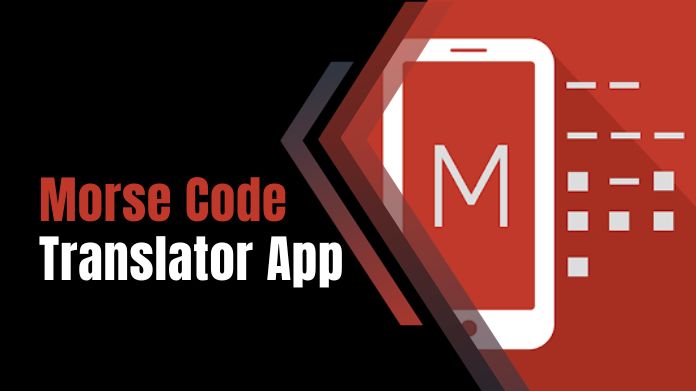Morse code, with its timeless simplicity, has left an indelible mark on communication. Creating a Morse Code Translator App offers a fusion of tradition and technology in an era of digital innovation.
This Morse Code Translator guide embarks on a journey into coding, exploring the steps and considerations involved in developing an application that decodes the language of dots and dashes.
From understanding the basics of Morse code to implementing a user-friendly interface, this comprehensive guide aims to empower developers and enthusiasts alike to bring this historical method of communication to the digital forefront.
Whether diving into app development as a passion project or aiming to contribute a valuable tool to the digital landscape, this exploration will serve as your roadmap to transforming Morse code into a dynamic and accessible language in the digital realm.
What is a Morse Code Translator App?

Text can be converted into International Morse code and vice versa using a Morse code translator app. There is a translator for Morse code to assist users in encoding or decoding communications using the Morse code method.
Typically, the application features an interface that lets users enter text and view the equivalent representation in Morse code. Additionally, viewers can see the decoded text by entering Morse code.
Moreover, certain Morse code translation apps might let you save or share the messages, copy and paste text or code, and hear the encoded or decoded words back.
These applications can help with learning Morse code, practicing encoding and decoding messages, and preparing for emergencies where Morse code could be needed as a backup form of communication. One of the most excellent app ideas for companies is to create a translator for Morse code. Thus, consider it if your firm is set to launch.
What is the International Morse Code?
The International Morse Code Translator is a standardized system that uses sequences with two distinct signal durations to represent letters, numbers, and punctuation marks.
It can also encode messages in various formats, like audio signals and flashing lights. Mainly, it is used for message transmission through telecommunication devices like radios and telegraphs.
Initially created for telegraphy in the middle of the 19th century, the Morse code translator was later modified for use in early radio communication.
Even with abundant communication channels, international Morse code is still used today. As a result, in 2023 and beyond, developers are looking for the finest approaches to create Morse code translation apps.
The Functionality of Morse Code Translation Mobile Apps
The functionality of Morse Code translation mobile apps is essential for individuals interested in communicating using Morse Code. These apps serve as convenient tools for translating text into Morse Code and vice versa, allowing users to send and receive messages quickly.
One of the primary features of Morse Code translation mobile apps is their ability to convert text into Morse Code. Users can input the desired text, and the app will translate it into the corresponding Morse Code symbols. This feature is handy for individuals learning Morse Code or needing assistance composing messages.
Additionally, Morse Code translation mobile apps often include the functionality to decode Morse Code into readable text. This feature is valuable for individuals receiving Morse Code messages, as they can input the series of dots and dashes and translate it into understandable text. This eliminates the need for manual decoding, saving time and effort.
Furthermore, many Morse Code translation mobile apps offer additional features to enhance the user experience. These may include customizable settings, such as adjusting the speed of Morse Code transmission or changing the sound of the dots and dashes. Some apps even provide interactive tutorials or games to help users improve their Morse Code skills and knowledge.
In terms of user interface, Morse Code translation mobile apps are created to be user-friendly and intuitive. They typically have a simple layout with clear instructions, making it comfortable for users to navigate and utilize the various features. This is particularly important for individuals new to Morse Code and may need guidance in using the app effectively.
How to Develop a Morse Code Translator App?
Developing a Morse Code Translator App involves several key steps, combining understanding Morse code principles with coding and user interface design.
Here’s a general guide to help you embark on this coding journey:
1. Understand Morse Code:
Please familiarize yourself with Morse code, its symbols, and the encoding/decoding principles. Morse code consists of dots (.) and dashes (-) representing letters and numbers.
2. Choose a Development Platform:
Decide on the platform for your app (iOS, Android, web-based, etc.). This choice will influence the programming languages and tools you’ll use.
3. Select Programming Languages:
Choose a programming language suitable for your platform. For example, Swift or Objective-C for iOS, Kotlin or Java for Android, or JavaScript for web-based apps.
4. Design the User Interface:
Create an intuitive and user-friendly interface. Include input fields for users to type or paste text, buttons for encoding and decoding, and a display area for results.
5. Implement Morse Code Logic:
Write the logic to translate text into Morse code and vice versa. Assign Morse code representations to each letter and number in your app’s logic.
6. Coding the App:
Begin coding your app, incorporating the chosen programming language and the Morse code logic you’ve developed. Pay attention to error handling and edge cases.
7. Testing:
Test your app thoroughly to ensure accurate translation and a smooth user experience. Test with various inputs to cover a range of scenarios.
8. User Feedback:
Gather feedback from potential users or beta testers. Use this input to refine your app, addressing any usability issues or bugs that may arise.
9. Optimize for Accessibility:
Consider accessibility features, ensuring your app is usable by individuals with different abilities. This may include voiceover functionality and text-to-speech features.
10. Publish Your App:
Once satisfied with your app’s performance and user experience, publish it on the chosen app store or distribution platform.
11. Promotion and Updates:
Promote your Morse Code Translator App to reach a wider audience. Regularly update the app based on user feedback, adding features or addressing issues.
Whether you’re developing this app as a coding project or a practical tool for Morse code enthusiasts, this guide provides a foundational framework to bring your Morse Code Translator to life.
Final Note
Developing an application in Morse code can be difficult, but if you know much about “How to develop a Morse code translator app?” you can do the development process like an expert.
Create a business application that meets user needs and is practical by following all the stages outlined in this blog post.
Thanks for reading!!
